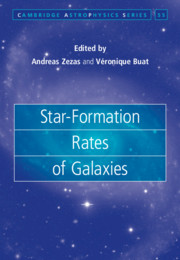Book contents
- Frontmatter
- Contents
- List of Figures
- List of Tables
- List of Contributors
- Preface
- Part I Background
- 1 Introduction
- 2 The Initial Mass Function of Stars and the Star-Formation Rates of Galaxies
- 3 Stellar Populations, Stellar Evolution, and Stellar Atmospheres
- 4 Dust Extinction, Attenuation, and Emission
- Part II SFR Measurements
- Index
4 - Dust Extinction, Attenuation, and Emission
from Part I - Background
Published online by Cambridge University Press: 11 May 2021
- Frontmatter
- Contents
- List of Figures
- List of Tables
- List of Contributors
- Preface
- Part I Background
- 1 Introduction
- 2 The Initial Mass Function of Stars and the Star-Formation Rates of Galaxies
- 3 Stellar Populations, Stellar Evolution, and Stellar Atmospheres
- 4 Dust Extinction, Attenuation, and Emission
- Part II SFR Measurements
- Index
Summary
Dust impacts observations of stars and gas in galaxies by absorbing and scattering photons. Correctly accounting for the effects of dust allows for more accurate studies of a galaxy's stars and gas while also enabling the study of the dust grains themselves.The impact of dust on measurements of individual stars in a galaxy can be straightforwardly modeled as extinguishing the stellar light. Dust extinction towards a star is defined as the combined effect of absorption of photons and scattering of photons out of the line-of-sight towards the star. For integrated measurements of regions of galaxies or whole galaxies that contain multiple stars intermixed with dust, the effects of dust are termed attenuation and are harder to model. Integrated measurements include stars extinguished with different amounts of dust and scattering of photons into the measurement aperture. The infrared dust emission powered by the absorbed photons provides a vital measurement of the amount of energy absorbed by dust. This infrared measurement is not possible for individual stars butprovides an important constraint in modeling the effects of dust on integrated measurements. The aim of this chapter is to provide the details of dust extinction, attenuation, and emission and recommendations for how to model the effects ofdust on observations.
- Type
- Chapter
- Information
- Star-Formation Rates of Galaxies , pp. 96 - 112Publisher: Cambridge University PressPrint publication year: 2021



